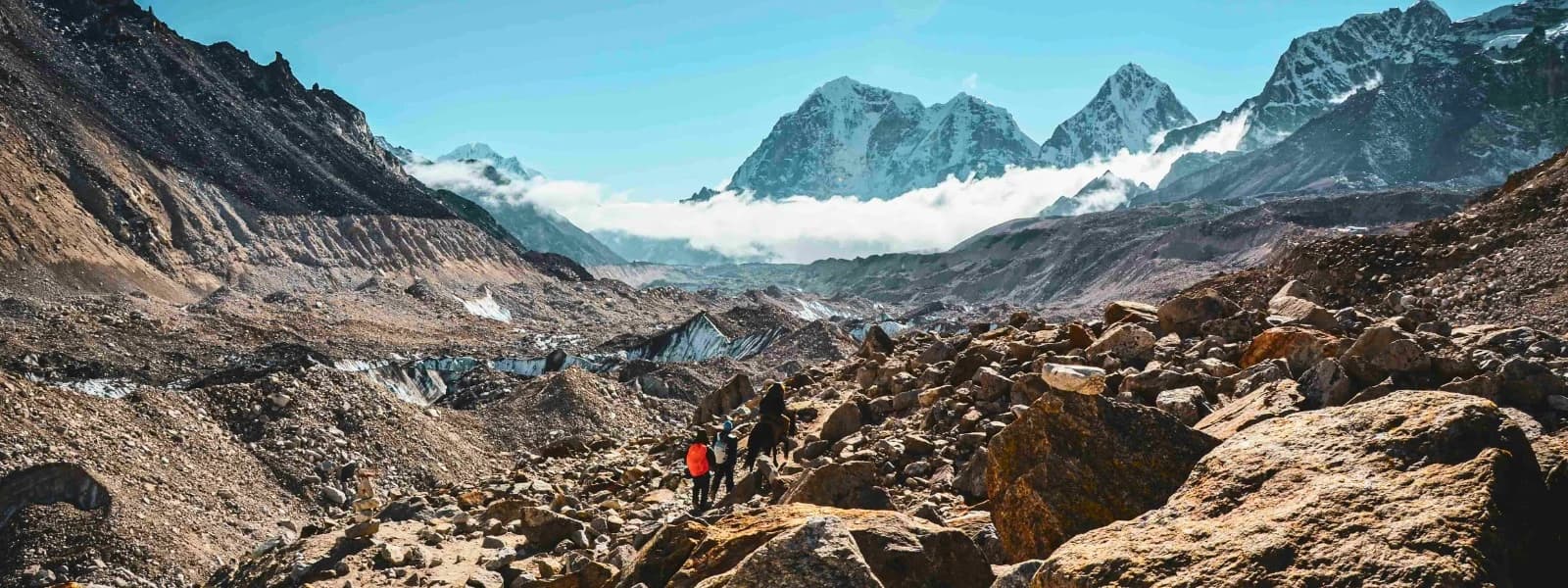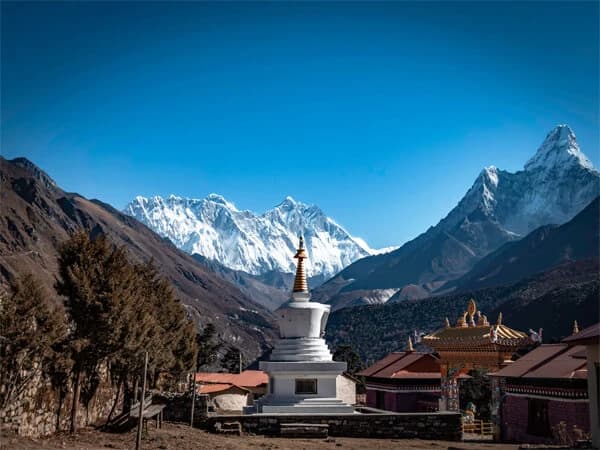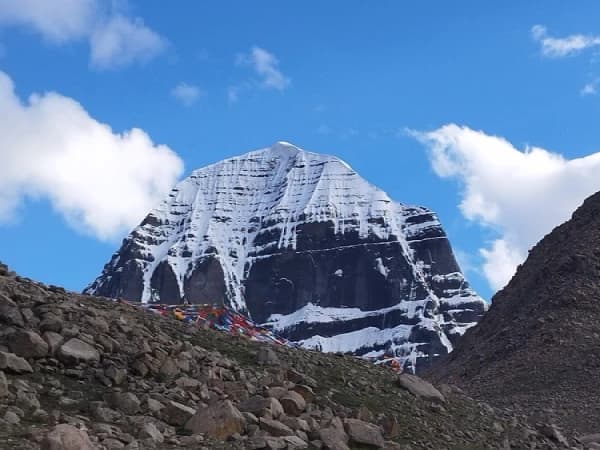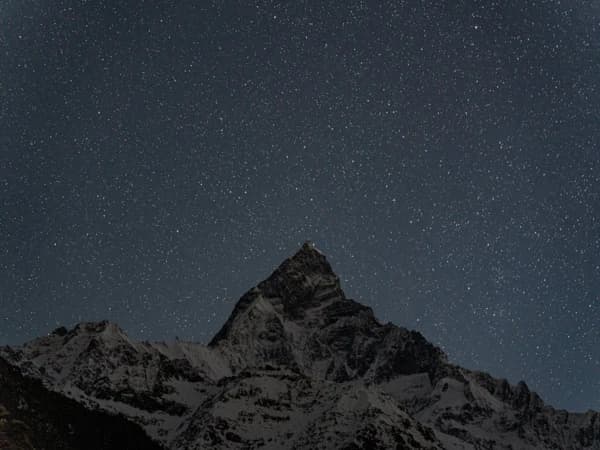Mount Everest Base Camp, at 5,364 meters (17,598 feet) in Nepal, challenges trekkers with high altitude and reduced oxygen, demanding careful acclimatization. Despite these difficulties, the camp offers breathtaking views of the Himalayan peaks.
Everest Base Camp Elevation
Everest Base Camp (EBC) is a goal for thousands of trekkers each year, luring adventurers worldwide to Nepal for its legendary trails and breathtaking Himalayan vistas. Reaching Everest Base Camp is a high-altitude trek, so understanding the elevation, acclimatization, and physical preparation is essential for anyone considering this adventure. Let’s dive into what to expect along the way.
Understanding the Elevation of Everest Base Camp

What is the Elevation of Everest Base Camp?
Everest Base Camp sits at a staggering 5,364 meters (17,598 feet) above sea level. This elevation isn’t extreme by Everest’s summit standards, but it's still far above sea level and poses risks related to altitude. The Base Camp offers awe-inspiring views of Mount Everest and serves as the launching point for climbers who are ascending the world’s tallest peak.
Elevation Profile: Key Altitude Points from Start to Base Camp
The EBC trek features dramatic altitude gains, especially between major stops:
| Stop |
Elevation (meters) |
Elevation (feet) |
| Lukla | 2,860 m | 9,383 ft |
| Namche Bazaar | 3,440 m | 11,286 ft |
| Tengboche | 3,860 m | 2,664 ft |
| Dingboche | 4,410 m | 14,468 ft |
| Lobuche | 4,940 m | 16,210 ft |
| Gorak Shep | 5,164 m | 16,942 ft |
| Everest Base Camp | 5, 364 m | 17,598 ft |
This steep ascent makes acclimatization a top priority, particularly in spots like Namche Bazaar and Dingboche.
Comparison with Other High-Altitude Treks and Summits
Compared to other popular high-altitude treks like the Annapurna Circuit or Manaslu Circuit, Everest Base Camp has a unique allure and difficulty level. Although not as intense as climbing peaks, the EBC trek reaches elevations where altitude sickness can become a serious concern.
Elevation Details
Height: The elevation of Everest Base Camp is 5,364 meters (17,598 feet) above sea level123.
Comparison with Other Base Camps: There are two main base camps for Mount Everest:
South Base Camp (Nepal): 5,364 m (17,598 ft)
North Base Camp (Tibet): Approximately 5,150 m (16,900 ft) 23.
Popularity : EBC is one of the highest tourist destinations globally and attracts thousands of trekkers each year. Famous than like Mont Blanc (4,807 m or 15,771 ft) and the Matterhorn (4,478 m or 14,692 ft)
Altitude Gain on the Everest Base Camp Trek

Trekkers typically experience daily altitude gains of 366 to 488 meters (1,200 to 1,600 feet) after reaching Namche Bazaar, where acclimatization begins.
Starting Point: Lukla (Elevation and Overview)
The EBC trek starts inLukla (2,860 meters), accessible only by a small plane ride from Kathmandu. The adventure begins here, where trekkers acclimate to thin mountain air before moving onward to Namche Bazaar.
Namche Bazaar: First Major Altitude Gain
Namche Bazaar (3,440 meters) is the first major stopping point and hub for acclimatization. Here, trekkers spend an extra day allowing their bodies to adjust to the thinner air, while exploring local culture and enjoying sights of nearby peaks.
Tengboche and Dingboche: Acclimatization Points
Tengboche (3,860 meters) is known for its iconic monastery, where travelers often pause to soak in the views. Dingboche (4,410 meters), however, is a critical acclimatization stop. With another scheduled acclimatization day, trekkers explore the valley and get accustomed to higher elevations, helping to prevent altitude sickness.
Gorak Shep to Base Camp: Final Push and Elevation Details
The final push from Gorak Shep (5,164 meters) to Everest Base Camp takes trekkers to their goal elevation of 5,364 meters. This segment is challenging, with cold temperatures, rugged terrain, and minimal oxygen levels. Reaching Base Camp, however, is an exhilarating payoff to a tough climb.
The Science of Altitude and Elevation Effects

How Altitude Affects Oxygen Availability in the Body
At higher altitudes, air pressure drops, meaning there’s less oxygen per breath. This can result in decreased performance and fatigue as the body struggles to supply sufficient oxygen to muscles and organs.
Understanding Atmospheric Pressure Changes at High Elevations
Atmospheric pressure decreases significantly as elevation increases. At Everest Base Camp, oxygen levels are around 50% of sea level, which requires trekkers to slow their pace and acclimatize properly to avoid serious complications.
Effects of Elevation on Physical Performance and Fatigue
As altitude rises, physical performance drops. Trekkers will experience increased fatigue, slower recovery, and even mild confusion. Each day brings new altitude challenges, so preparation and pacing are key to handling these effects effectively.
Effects of High Elevation on the Body

Why Altitude Affects the Body: Oxygen Levels and Breathing
When the body gets less oxygen, it compensates by increasing breathing and heart rates. This adjustment helps deliver oxygen but can lead to symptoms like dizziness, nausea, and breathlessness.
Common Symptoms of Altitude Sickness
Altitude sickness symptoms include headaches, nausea, and insomnia. These symptoms are common but need attention, especially if they worsen, as they can signal serious conditions like high-altitude pulmonary edema (HAPE) or high-altitude cerebral edema (HACE).
Serious Risks: High-Altitude Pulmonary and Cerebral Edema (HAPE & HACE)
In severe cases, altitude sickness can lead to HAPE (fluid in the lungs) or HACE (brain swelling), both of which are life-threatening and require immediate descent.
How Acclimatization Helps: Adjusting to the Elevation
Proper acclimatization, including rest days, hydration, and a gradual ascent, allows the body to adapt to higher elevations. This is critical for safety and a successful trek.
Acclimatization Strategy on the Everest Base Camp Trek

Importance of Acclimatization Days
Acclimatization days are essential to combat altitude sickness. Trekking guides include these days in the itinerary to allow your body time to adjust to changing altitudes.
Recommended Acclimatization Stops: Namche Bazaar and Dingboche
Stops in Namche Bazaar and Dingboche allow trekkers to explore the region while acclimating. These stops are crucial to ensure safe altitude gains in the days ahead.
Strategies for Effective Acclimatization: Hydration, Rest, and Gradual Ascent
Staying hydrated, resting, and pacing oneself helps reduce altitude sickness risks. Drinking enough water helps counteract the dehydrating effects of high altitude.
Advanced Acclimatization Techniques: Oxygen Tanks, Altitude Chambers, and Training Masks
For those seeking extra preparation, portable oxygen tanks, altitude chambers, and training masks are available. However, these techniques are typically used by trekkers with existing altitude sensitivity or in emergencies.
Recognizing When to Descend for Health and Safety
If altitude sickness symptoms worsen, it’s essential to descend immediately. Delaying can lead to severe health issues, so don’t ignore serious symptoms.
Physical Effects of Trekking at High Elevation

How Altitude Affects Sleep Quality and Recovery
Sleep disturbances are common at high altitudes. Limited oxygen can make sleep restless, impacting recovery and energy levels during the trek.
Managing Physical Exhaustion with Limited Oxygen
Endurance drops at high altitudes, so trekkers must manage energy carefully, conserving strength for tougher segments like the Gorak Shep-to-Base-Camp push.
Handling Cognitive Impairment at High Elevations
High-altitude trekking can lead to mild cognitive impairment, affecting decision-making. Recognize this effect to stay alert and avoid risky behaviors on the trail.
Preparing Physically and Mentally for High Altitude

Physical Training for Altitude: Cardiovascular and Endurance Exercises
Strengthen your cardiovascular and muscular endurance with targeted training. Focus on hiking, running, and interval training to prepare for the long days and steep ascents of the EBC trek.
Mental Preparation: Coping with Trek Challenges and Discomforts
Mental resilience is key. Trekking EBC requires pushing through fatigue, discomfort, and sometimes limited comfort facilities, so come prepared mentally for the demands of the journey.
Essential Gear for High Altitude: Clothing, Sleeping Bags, and Oxygen Meters
High-quality, layered clothing, thermal sleeping bags, and oxygen meters are essential. These items help ensure comfort and safety in the harsh mountain climate.
Diet and Hydration Tips to Maintain Energy and Health
Focus on high-calorie, nutritious meals and consistent hydration. Eating well and drinking enough water can help counteract fatigue and altitude-related symptoms.
Everest Base Camp Trek Itinerary with Altitude Points

14-Day Everest Base Camp Trek Itinerary
Day 1: Arrival in Kathmandu
Day 2: Kathmandu Sightseeing
Day 3: Fly to Lukla & Trek to Phakding
Day 4: Trek to Namche Bazaar via Monjo
Day 5: Acclimatization Day in Namche Bazaar
Day 6: Trek to Deboche via Tengboche Monastery
Day 7: Trek to Dingboche via Pangboche
Day 8: Trek to Lobuche via Dughla Pass
Day 9: Trek to Gorak Shep & Everest Base Camp, return to Gorak Shep
Day 10: Hike to Kala Patthar & Trek to Pheriche
Day 11: Trek to Namche Bazaar
Day 12: Trek to Lukla
Day 13: Fly back to Kathmandu, Farewell Dinner
Day 14: Final Departure
Day-by-Day Altitude Gains and Distances
Each day brings a unique combination of distances and altitude gains, with stops planned for rest and acclimatization. The itinerary ensures a balance of hiking challenges and health considerations.
Notable Stops and Their Elevations: Lukla, Namche Bazaar, Tengboche, Dingboche, Gorak Shep, and Base Camp
Each major stop offers unique views, acclimatization benefits, and chances to explore the unique culture of the Khumbu Valley.
Side Treks and Alternative Routes (e.g., Gokyo Lakes)
Alternative routes like the Gokyo Lakes trekprovide stunning views of Everest from different angles and can add a rewarding twist to the traditional EBC journey.
Reaching Everest Base Camp is a challenging yet unforgettable journey. With proper preparation and respect for high-altitude conditions, trekkers are rewarded with breathtaking views and the satisfaction of standing at the base of the world’s highest mountain. So, gear up and start planning for one of the world’s most iconic trekking adventures.
Final Thoughts
Reaching Everest Base Camp is a journey filled with breathtaking views, physical challenges, and the achievement of altitude mastery. At 5,364 meters, the trek demands careful acclimatization and a well-thought-out physical and mental preparation. From the starting elevation in Lukla at 2,860 meters to the final approach through Gorak Shep, each step toward Everest Base Camp's elevation demands endurance, patience, and respect for altitude.
Preparation is key to conquering the altitude, especially at crucial acclimatization points like Namche Bazaar and Dingboche. With acclimatization days, gradual ascents, and essential high-altitude gear, trekkers reduce risks like altitude sickness and improve their chances for a safe, successful journey. As you push toward the Base Camp, you’ll encounter unforgettable vistas and an unparalleled sense of achievement.
Make your Everest Base Camp trek dream a reality with our experienced team at Regulus Nepal. Our expert guides ensure safety, comfort, and a seamless experience, allowing you to focus on the journey ahead. Connect with us on Facebook or contact us directly to start planning your high-altitude adventure today!
Frequently Asked Questions
How hard is it to hike to Everest Base Camp?
The trek to Everest Base Camp is considered a challenging high-altitude trek but does not involve technical climbing. Hikers face difficulty mainly due to the high altitude, which can lead to altitude sickness. The trek usually takes 11–14 days, covering rugged trails, steep inclines, and cold temperatures, especially as you near Base Camp (5,364 meters or 17,598 feet). Physical fitness, acclimatization, and good preparation are crucial to success.
Can beginners do Everest Base Camp?
Yes, beginners with good physical fitness and mental preparedness can complete the Everest Base Camp trek, though it's recommended to have some trekking experience. Training for endurance and preparing for altitude are critical to increase chances of success. Beginner hikers should also consider longer acclimatization schedules to help adapt to the altitude.
Is Everest Base Camp harder than Kilimanjaro?
Yes, generally, the trek to Everest Base Camp is considered longer and often more challenging than the climb up Kilimanjaro. Although Kilimanjaro (5,895 meters or 19,341 feet) is higher, the EBC trek involves a longer duration (typically around two weeks) and more gradual acclimatization to altitude. Kilimanjaro’s ascent is shorter (5–9 days) but steeper, with a rapid altitude gain that can make altitude sickness a more immediate concern.
Can you go higher than Everest Base Camp?
Yes, it is possible to trek beyond Everest Base Camp. Trekkers can continue to Kala Patthar (5,545 meters or 18,192 feet), a nearby peak that offers an excellent view of Mount Everest. However, going beyond EBC into the higher altitudes on Everest itself is only for trained mountaineers with permits and specialized gear. This requires a separate expedition and is far more demanding and dangerous.
Can a normal person climb to Everest Base Camp?
Yes, an average person with a good fitness level, determination, and preparation can trek to Everest Base Camp. No technical climbing skills are needed, but due to the altitude, stamina, and potential weather extremes, hikers should prepare through cardiovascular training and gradually acclimate to higher altitudes during the trek.
Do you need oxygen at Everest Base Camp?
No, supplemental oxygen is not typically needed for the Everest Base Camp trek, as EBC is at 5,364 meters, where many trekkers can acclimatize without it. However, some trekkers may carry portable oxygen in case of altitude sickness, although acclimatization and a gradual ascent usually mitigate this need.
What is the success rate of the Everest Base Camp trek?
The estimated success rate for the Everest Base Camp trek is high, often around 90–95% with proper acclimatization. Most trekkers reach EBC if they allow enough time to adapt to altitude. Altitude sickness is the primary reason for not completing the trek, underscoring the importance of acclimatization and a sensible pace.









